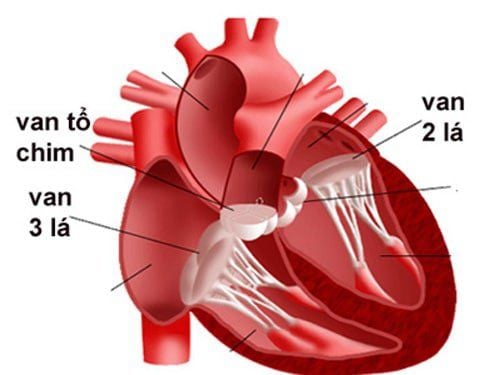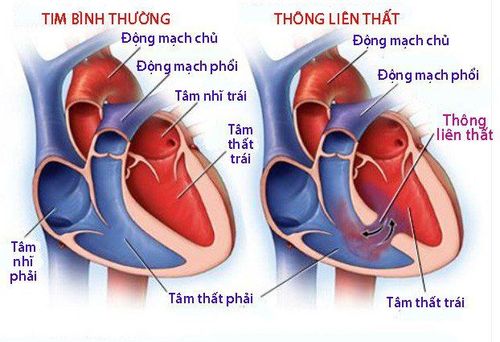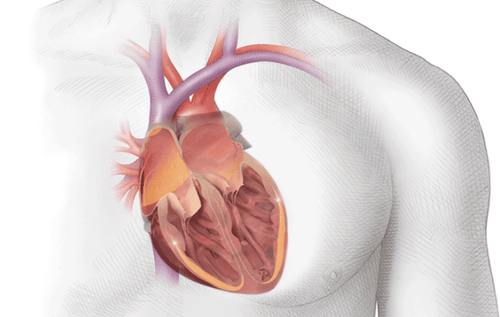This is an automatically translated article.
Tricuspid atresia is a congenital heart defect in which the tricuspid valve does not form properly. Instead, the heart muscle tissue here grows stronger, restricting blood flow and causing the right ventricle to underdevelopment, so often accompanied by a unique ventricular systole. Infants, children, or adults with tricuspid atresia can't get enough oxygen through the body, so they get tired easily, often have trouble breathing, and have bluish-blue skin.1. What is tricuspid atrophy?
Tricuspid atresia is a birth defect of the tricuspid valve - the heart valve that controls blood flow from the right atrium to the right ventricle. This condition occurs when the tricuspid valve does not form at all and no blood flow can go from the right atrium through the right ventricle to the lungs for oxygen. Because a baby with a tricuspid defect may need surgery or other interventional procedures soon after birth, tricuspid atrophy is considered a serious congenital heart defect.In children without congenital heart defects, the right ventricle is responsible for pumping oxygen-poor blood from the heart to the lungs through the pulmonary artery. The blood returning from the lungs is rich in oxygen and can then be pumped by the left ventricle to the rest of the body through the aorta.
In infants with tricuspid atresia, because the tricuspid valve that controls blood flow from the right atrium to the right ventricle is not formed, blood cannot reach the right ventricle and to the lungs. For this reason, the right ventricle may be underdeveloped. Pulmonary arteries can also be small with very little blood going through to reach the lungs.
Thus, in atrophy of the tricuspid valve, because blood cannot flow directly from the right atrium to the right ventricle, blood must use other routes to pass through the unshaped tricuspid valve. Babies born with tricuspid regurgitation often also have an atrial septal defect, which is a hole between the right and left atria, also known as a ventricular septal defect, which is a hole between the right and left ventricles. These defects allow oxygen-rich blood to mix with oxygen-poor blood, so that oxygen-rich blood has a way of being pumped to the rest of the body.
2. Causes and risk factors of tricuspid atresia
The cause of congenital heart defects, such as tricuspid atresia in particular, in most neonates remains unknown.Some children have heart defects because of changes in genes or chromosomes. Furthermore, heart defects are also thought to be caused by a combination of genes and other factors, such as those exposed by the mother in the environment or what the mother eats or drinks, and certain medications. use during pregnancy.

Teo van 3 lá là một dị tật tim bẩm sinh nghiêm trọng
3. How is tricuspid atrophy diagnosed?
Tricuspid atresia can be diagnosed during pregnancy or soon after the baby is born.3.1 During Pregnancy During pregnancy, there are screening tests (also called prenatal tests) that play a role in checking for congenital heart defects as well as other conditions. Tricuspid atrophy can be seen on fetal echocardiography.
Fetal echocardiography is a special tool to examine the fetal heart structure in the uterine cavity and major blood vessels. This form of ultrasound can also show problems with the heart's structure and how the heart is working in response to these defects.
3.2 After birth Infants born with tricuspid atrophy in particular or cyanotic congenital heart disease in general will show symptoms from birth or very soon after. Babies may have a bluish skin color, called cyanosis, because the blood pumped out into the large circulation doesn't carry enough oxygen.
In addition, infants with tricuspid atrophy may have additional symptoms, such as:
Have breathing problems Gray or bluish skin color Poor suckling Lethargy, less flexibility. If your doctor suspects that there may be a heart problem, your doctor may order one or more tests to confirm the diagnosis of tricuspid hypoplasia. The most common tool is an echocardiogram, which can show problems with the heart's structure, like holes between the chambers and any abnormal blood flow.
In addition, cardiac catheterization, by inserting a thin tube into a blood vessel and leading to the heart, can also confirm the diagnosis by looking inside the heart indirectly and measuring blood pressure, oxygen saturation each time. location. An electrocardiogram to measure the electrical activity of the heart and other medical tests may also be used to make a diagnosis.

Teo van 3 lá có thể được phát hiện khi siêu âm tim thai
4. How to treat atrophy of the tricuspid valve?
4.1 Medicine Some infants and children with tricuspid atresia will need medications that strengthen the heart muscle, lower blood pressure, and diuretics to help the body get rid of fluids.4.2 Nutrition Some infants with tricuspid atresia become tired while feeding and do not eat enough to gain weight. Therefore, to ensure a healthy weight gain, your baby may need special high-calorie formula interventions.
In addition, if the baby is not able to latch on well, it may be necessary to feed through a feeding tube directly into the stomach.
4.3 Surgery Surgical treatment for tricuspid hypoplasia depends on the severity and presence of other concomitant cardiac defects.
Accordingly, as soon as an infant with tricuspid atresia is born, one or more surgeries may be necessary to increase blood flow to the lungs and remove the dysfunctional right ventricle. effective.
In summary, tricuspid atrophy is a congenital heart defect. This means that the heart's tricuspid valve does not develop from birth. Because the blood flow of the heart is abnormal, the amount of blood to the lungs is less, the body will not receive the necessary amount of oxygen, so the child will have blue-violet skin. Accordingly, children need to receive timely interventions, including medical and surgical, that can maintain life.
Cardiovascular Center, Vinmec International General Hospital is also one of the leading spearhead centers, with a full team of experts including: Professor, Doctor, Specialist 2, Master. rich experience, great reputation in the field of medical treatment, surgery, interventional cardiac catheterization and application of advanced techniques in the diagnosis and treatment of cardiovascular diseases.
In particular, the Center has modern equipment, on par with the most prestigious hospitals in the world. This is also the first private hospital and the second hospital in Vietnam to successfully implement the HVAD ventricular-assisted artificial heart transplant technique. Performed 18 transcatheter aortic valve replacement - One of the most complex cardiovascular intervention techniques in the world today within more than 1 year; performed the first MitraClip case and hundreds of aortic and coronary interventions, including complicated and difficult-to-access cases.
Please dial HOTLINE for more information or register for an appointment HERE. Download MyVinmec app to make appointments faster and to manage your bookings easily.













